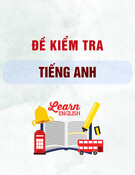
TRƯỜNG CD VĂN HÓA NGHỆ THUẬT VÀ DU LỊCH SÀI GÒN
ĐỀ THI ANH VĂN NGÀNH THÔNG DỊCH VIÊN ANH-PHÁP 2009 – 2010
THỜI GIAN: 90 PHÚT
I/ True (T) or False (F)
1. The U.S nat ional government has no responsibilities to it s education?
2. Educat ion of all ages in t he U.S is under the direct control of state and
local government.
3. Fund for running schools is provided by t he U.S federal gover nment and
taxes.
4. The nat ional Board of Education decides the curriculum and general
st andard of educat ion.
5. In the U.S, educat ion from school to universit y is free of charge.
6. Only st udents from elite private schools have chances t o go to t he best
American
Universities.
7. The majority of students at Harvard Universit y are from elite private school
8. It is more difficult to get a chance to study at Harvard now than it was
before t he
World War II.
9. All of the stat es in the U.S have their ow n universit ies.
II/ Answer the questions
1. What is K – 12?

2. What do American children learn at element ary schools?
3. What are “ electives” ? At what level of educat ion are American children
offered elect ives?
4. What is “ school board” ? What does it do?
5. What kind of school conflicts with the ideal of equalit y of opportunity?
Why? Why do parents want t heir children to go to this kind of school?
6. Who is John Dew ey? What are his two import ant ideas that influence the
American teaching
model?
7. What are t he four principles of the American teaching model? Give
examples for each.
8. What is Special Educat ion?
9. What are the two tracks of study provided by most high schools?
10. What are the different types of colleges in the United States?
11. What does a student take int o considerat ion when choosing a college?
12. How to get accepted into a college?
13. W hat are t he t wo things which prevent many American st udents from
attending universit y?
14. What kinds of courses does an American college student take?
15. W hy do you think American universit ies are somet imes crit icized for
offering too many elect ives? What is t he advantage of doing so?
16. Where do American universities get money to run t heir instit ut ions?
III/ Below is the American education ladder. Fill in the missing information.

Education
ladder
A
g
e
required
Grades
1.
(1)
5
2.
(2)
6
-
11
1
s
t
–
6
t
h
3.
S
econd
a
ry
schools
+ Junior high school/ middle schools
+ High schools
12- 13/ 14
14/ 15
-
18
7t h – 8th/ 9t h
t
h
t
h
4.
Hi
g
her
education
De
g
rees

4
.
1
Under
g
r
a
duate
studies
Bachelor
de
g
r
e
e/ coll
e
g
e
4
.
2
Professional
st udies
4
.
3
(4)
M aster’s
d
e
g
ree
or
Doctoral
de
g
ree
* Religious inst ruct ion is offered by American religious private school but not
by
* An American st udent usually spends _ years at college to have a bachelor
degree.
* A lar ge American Universit y typically consist s of several colleges, program,
one or more schools.
IV/ Choose the correct answer.
1. Which of t hese statements is not true?
a. American high school st udents have the choice of going to a free public
school or a private one w here they must pay tuit ion.
b. The American education system is based on strong principles of equality of
opportunity.
c. After 12 years of schools American st udents receive a bachelor’s degree
diploma at graduat ion.
2. Which of these st atements is

true?
a. M ost of the money to pay for American public schools comes from
local taxes.
b. Religious schools that serve middle-class student s receive money
from the national government, but elite private schools do not.
c. The nat ional Depart ment of Educat ion determines the curriculum f or all
schools and sets t he standard for high school graduat ion and college
admission.
3. Since 1900, t he percentage of young Americans who attend college has . .
. . . .
. a. Increased slight ly from less t han 10 percent to about 20
percent. b. Increased enormously from 10 percent to over 60
percent.
c. Stayed about t he same, at around 20 percent.
4. What most Americans like most about higher education is . . . .
. . . . a. Its cultural value.
b. Its monetary
value. c. Its moral
value.












![Đề thi Tiếng Anh có đáp án [kèm lời giải chi tiết]](https://cdn.tailieu.vn/images/document/thumbnail/2025/20250810/duykpmg/135x160/64731754886819.jpg)



